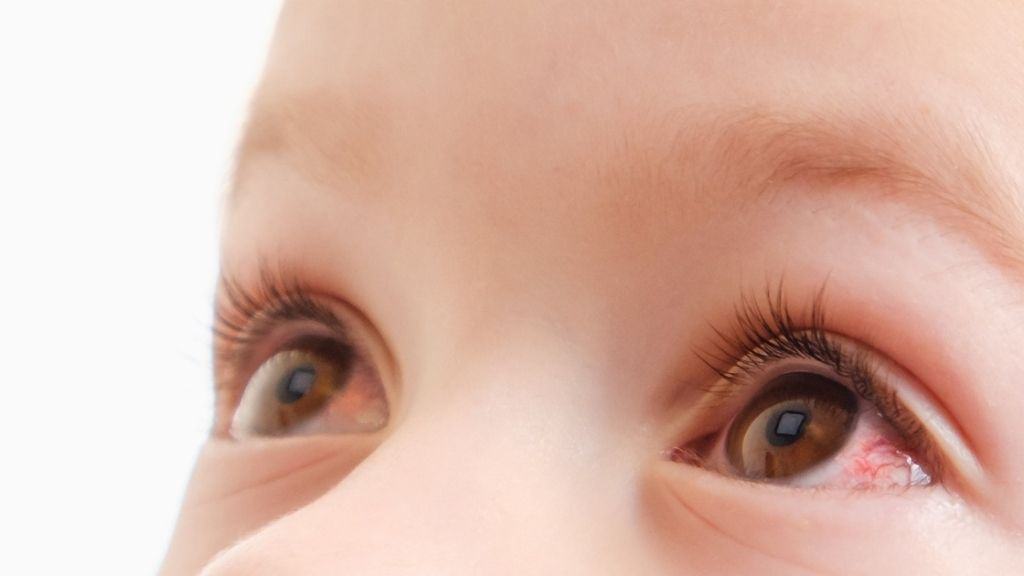
Table of Contents
Have you been noticing redness in your newborn’s eye even though he or she didn’t cry? Then we understand your worries and have curated this document of all the red rashes babies could get.
Let’s take a look at why a baby Red Around Eyes in the corner!
Common Causes Of Baby Red Around Eyes
1. Rubbing
The most delicate area of the human body is the skin around the eyes. For that very reason, wrinkles first start forming around the eyes. Rubbing is the most common cause of redness around the eyes.
Rubbing is not a cause of concern; it’s more worrying about why your baby is rubbing their eyes so much. Remember eyes + fingers equals a recipe for infections. However, if it is just a sleepy behavior your baby has picked up then you can try baby gloves to cover their teeny weeny hands or simply wait to see if it resolves on its own.
2. Irritants
Irritants can be termed as substances that injure, airways, skin, or eyes in one way or another. Irritants can be classified into two groups: outdoor and indoor. Irritants cause localized redness usually that will resolve on their own when you remove your baby from the area where this particular irritant exists. You could also identify the irritant and remove it from your home.
- Indoor Irritants: Indoor irritants could include,
- Cigarette smoke
- Perfumes
- Sunscreen
- Soaps
- Outdoor Irritants: Outdoor indoors could be,
- Smoke
- Fumes
- Chemical vapors
- Pool water chlorine
- Smog
3. Allergies
It’s called an allergy when our eyes or just any part of our body react with a particulate called allergen. An allergen can be defined as a harmless substance that triggers your immune system to respond to itself. Most common allergen include,
- Dust mites
- Perfumes in cosmetics and lotions
- Mold
- Medications
- Dander from pets
- Foods
- Pollen from plants, grass, weed, and trees
- Insect venom
If your baby has, unfortunately, come into contact with an allergen, their eyes will produce histamine to counteract the allergen. This is the reason their eyelids and conjunctiva become red, itchy, and swollen. Conjunctiva is the tissue that covers the white part of our eyes and is present under the eyelids.
Once the histamine is produced the eyes start watering excessively and then a vicious cycle sets in. Your kid will rub to relieve the itching which will cause the skin to burn, irritate the eyes even more and make it rain tears.
Some of the above-mentioned allergens are present around us all around the year while others come and go with seasons. For instance, if your baby is allergic to pollen then you can notice that their eyes are red when the pollen counts are high.
If your baby has eye allergies then they also tend to have nasal allergies too. Yes, it’s interconnected. If you think that the redness in a newborn’s eyes is an allergic reaction then take notice if your kids are sneezing or have a stuffy nose.
If allergic reactions tend to happen often, the body’s mast cells become over-sensitive. Mast cells are the first-line defense against foreign invaders. Mast cells in the eyes release histamine when they become over-sensitive even if there’s no contact with the allergen.
4. Infections
You can be sure it’s an eye infection if either virus or bacteria have entered the eyes. It’s important to understand the difference whether it’s a virus or a bacteria as bacterial conjunctivitis requires antibiotic treatment.
- Viral Conjunctivitis: Viral conjunctivitis, also called “pink eye“, can be bacterial too. Kids prone to excessive cold are commonly having viral eye infections. Watch out for these symptoms,
- Red eyelids on newborn babies
- Redness in the white part of the eye
- Watery eyes
- Bacterial Conjunctivitis: Bacterial conjunctivitis is more of a serious condition than a viral eye infection. This exhibit the same symptoms are viral infection along with these few symptoms,
- Sticky and yellow discharge from the eyes.
- Your baby’s eyelashes and eyelids may get stuck together from this discharge.
- Newborn Conjunctivitis:
- Red underneath a baby’s eyes may occur due to a blocked tear duct, infection, or irritation. This might be serious so contact your pediatrician right away.
5. Stye
A stye is also called a hordeolum and is one painful, red bump around a baby’s eyes due to infection of an oil gland, a hair follicle, or sweat glands. Check out for these symptoms apart from the bump,
- Redness of the eyelids
- Tenderness and swelling around the eyes
6. Periorbital Cellulitis
Periorbital cellulitis develops when your baby’s eye is injured or if he or she has a sinus infection. Thus is a kind of bacterial infection that affects the eyes and skin around them. It also makes the eyes swollen and red. It’s a pretty serious condition and needs immediate treatment.
Easy Remedies For Redness On The Eyelids of a Newborn
For immediate relief from red rashes around the eyes, you can try some home remedies. But if you are dealing with a newborn or you suspect the miscreant is cellulitis then get immediate medical treatment. Here we have brought together some immediate relief things to do for Baby red around eyes
1. Irritants
Try to pin down which irritant is causing the redness around the eyes and remove the culprit from your child’s vicinity. It could be shampoo, soap, or even laundry detergent.
2. Allergies
Allergies related to the eye exhibit themselves in different ranges of symptoms and it will also affect the airways and nasal passages. Keep track of what could be causing these allergic reactions. Here are some points to examine,
- What is on your little one’s daily menu?
- Is the allergic reaction seasonal?
- Does it happen at a particular place, such as daycare, or a relative’s or friend’s place?
- Is the allergy in any way related to animals?
- Are there any food allergies running in your families such as milk allergy, allergy to wheat or eggs?
3. Eye Infections
Viral Conjunctivitis
The first step to treat viral conjunctivitis is by rinsing the eyes with warm water.
- Take a cotton ball or a swab and dab your baby’s eyes with warm water.
- Remember to wash your hands before and after each cleaning.
- If you are a nursing mother then you can dab some of your milk onto the eye as human milk contains numerous healing properties.
- Do not rely on antibiotics as they do not work for viral infections.
The redness on the eyelids of a newborn will last for four to seven days.
Bacterial Conjunctivitis
Bacterial infection is identified by a sticky and yellow discharge. You use warm water or your milk to dab the eye but refer your doctor who will prescribe antibiotic eye creams or eye drops to fight this infection.
Newborn Conjunctivitis
Check your newborn’s eyes to see if there’s any redness around it and if there’s any immediately seek medical attention. If the medical team specifies a blocked tear duct then you can gently massage the opening of the tear duct and the lower region of the lower eyelid. This will help open up the blocked duct.
Sometimes your baby will be given antimicrobial eye drops right after birth which can affect his or her eyes. It is applied as your baby could get infected by the viruses or bacteria in the birth canal. This will however clear up within 24 to 36 hours after application.
4. Stye
You can use a warm compress on your baby’s eyes 3 to 4 times a day. This will ease the discomfort and eventually reduce the redness. Again, human milk is yet another great remedy for stye. Instead of warm water, you can use your milk too.
Talk To Your Pediatrician About Redness on The Eyelids of Your Newborn
When you go to your pediatrician with your newborn who is suspected to have bacterial conjunctivitis, he or she will-
- Prescribe topical treatment, such as ointment or eye drops.
- Prescribe oral antibiotics
- Prescribe intravenous antibiotics
Among these treatments, topical treatment is the most prescribed, oral antibiotics are the least prescribed whereas intravenous antibiotics are prescribed in very rare conditions. If your baby’s tear ducts are blocked, the medical expert can help you by showing you how to massage the duct area to open it up. Tear ducts open up on their own but if they don’t by the age of one, your child might need mild surgery. For bacterial conjunctivitis in your child. The pediatrician can prescribe antibiotics.
A Final Word on baby red around eyes
Every time your little one has something off going on you are bound to worry your head off. But Baby red around eyes is usually a simple task to deal with. Make sure you consult your pediatrician if there’s discharge in your baby’s eyes that are yellow in color and that stick to her or her eyelashes.









